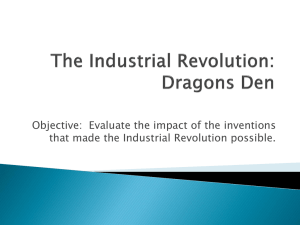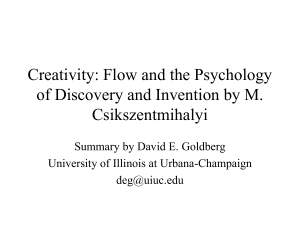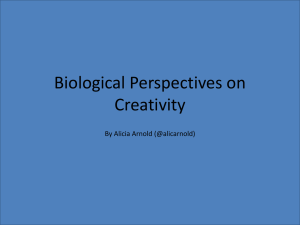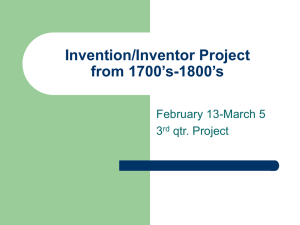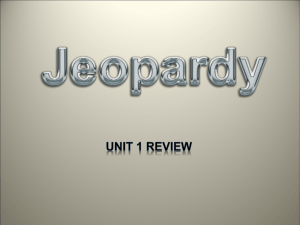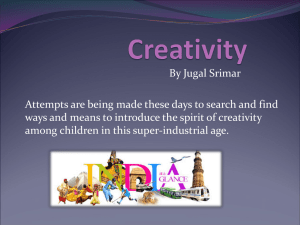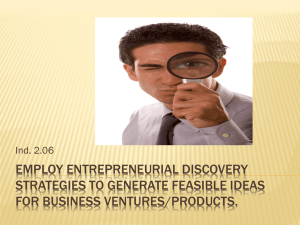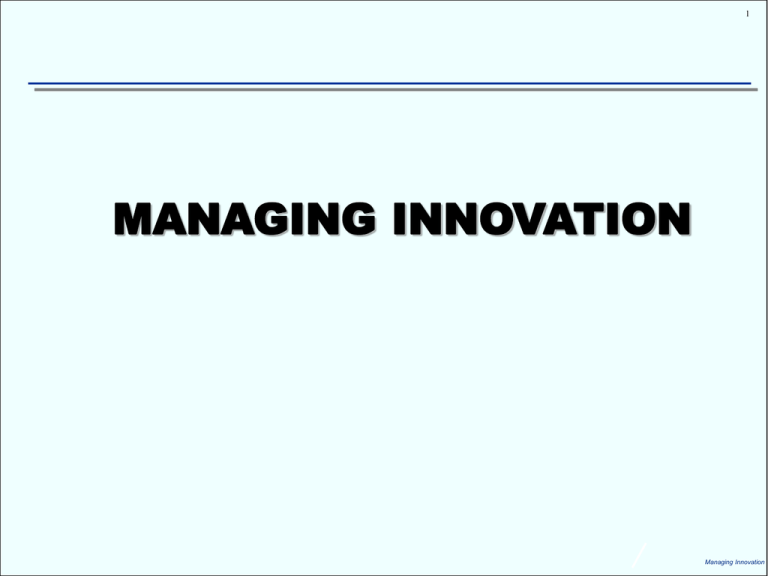
1
MANAGING INNOVATION
Managing Innovation
2
MANAGING INNOVATION
•
•
•
•
Introduction
What is invention and innovation
Different types of innovations
Models of innovation
Managing Innovation
3
THE IMPORTANCE OF INNOVATION
Corporations
must be able to change, adapt and evolve if they
wish to survive
By
1994-95, 275 books published in US had the word
“innovation” in their titles
“.. not to innovate is to die” - Christopher Freeman
Though
the term is now embedded in our language:
What is meant by innovation?
Do we fully understand the concept?
To what extend is this understanding shared?
Is a scientist’s view of innovation the same or different from that of
an accountant in the same company?
Why are some business more innovative than the others?
Is innovation at the heart of all companies’ activities?
Managing Innovation
4
THE IMPORTANCE OF INNOVATION
Certain
companies that have established themselves as
technical and market leaders have demonstrated an
ability to develop successful new products and to innovate
MARKET LEADERS
Industry
Aerospace
Pharmaceuticals
Motor cars
Computers & software
development
Market leaders ?
Airbus, Boeing
Pfizer, GSK, Novartis
Toyota, BMW
Microsoft, SAP, Intel
Managing Innovation
5
THE IMPORTANCE OF INNOVATION
IMPORTANT TECHNOLOGICAL INNOVATIONS
YEAR
NEW PRODUCT
COMPANY
1930s
PE
ICI
1945
Ballpoint pen
Reynolds Intl Pen
1950s
Float glass Pilkington
manufacturing process
1970/80s Zantac
GlaxoSmithKline
1970/80s Photocopying
Xerox
1980s
PC
Apple Computer
1980/90s Windows 95
Microsoft
1995
Viagra
Pfizer
2000s
Cell phones
Nokia
Managing Innovation
6
THE IMPORTANCE OF INNOVATION
QUESTION:
Not all firms develop innovative new products,
but they still seem to survive. Do they thrive?
Managing Innovation
7
THE IMPORTANCE OF INNOVATION
How a number of different disciplines contribute to our
understanding of the innovation process.
Scientific and
technological
developments
inevitably
lead
to knowledge
inputs
Firm’s develop
knowledge,
processes and
products
Societal changes and
market needs lead to
demands and opportunities
Managing Innovation
8
DEFINITIONS & VOCABULARY: Creativity
Creativity is the key to making change
Creativity is not a gift for a chosen few. Virtually everyone
is borne with creativity and uses it extensively during
childhood
While we don’t all have the same amount or type of
creativity, we use substantial more than a friction, perhaps
10%, of their natural creativity every day
Creativity has little connection to IQ, sex, age or any other
demographic factors
Most people can tap into more of their natural creativity by
learning a few basic process skills – and by using these
skills deliberately to “uncondition” themselves.
Managing Innovation
9
DEFINITIONS & VOCABULARY: Creativity
1.
2.
3.
4.
5.
How our attitudes suppress Creativity [1/2]
We try too hard to get along with others instead of trying to
introduce fresh facts and points of view.
We feel a need to account for all our actions instead of
visualizing the future or playing with ideas.
Wishing to be seen as practical and economical, we often
judge less than perfect ideas too quickly.
We worry about expressing doubt or ignorance or asking
‘Why’ about things that everyone accepts; we try to be polite
and not placing others on the defensive.
We favour the adversarial approach to making decisions and
resolving issues; like the adversarial nature of the courtroom
and the political arena. Developing a good solution becomes
secondary, we think how to win at all costs.
Managing Innovation
10
DEFINITIONS & VOCABULARY: Creativity
How our attitudes suppress Creativity[2/2]
6. We desire the safety of the known and familiar
instead of venturing new ideas.
7. Because we know too much about our work, we
often squelch open-minded consideration of new
ideas.
8. Reluctant to admit that others’ ideas are better than
our own, we reject attempts to improve our ideas.
Accepting an improvement would be like admitting
that our original idea was wrong.
9. We are unable to built on imperfect ideas trying to
have the “perfect” idea otherwise we won’t go
ahead.
Managing Innovation
11
DEFINITIONS & VOCABULARY: Creativity
How our behaviors suppress Creativity[1/2]
1. Because we fear appearing foolish, we do
anything to avoid making mistakes and looking
bad.
2. Our distrust of others’ motives makes us hesitant
about sharing information or venturing new ideas.
3. Rather than solve the ‘real’ problem, we go with
the first available solution and fail to uncover
better possibilities.
4. Believing there is one right answer to any
problem, we are content to stop with a workable
solution.
Managing Innovation
12
DEFINITIONS & VOCABULARY: Creativity
How our behaviors suppress Creativity[2/2]
5. We try to solve a problem immediately; we lack the
confidence to let the problem incubate for a time. We
feel that, if we don’t solve the problem immediately,
we have somehow failed.
6. We feel compelled to solve a problem directly instead
of taking apparently off-course detours.
7. After finding a workable solution, we fail to drive the
problem solving process through to implementation.
8. We are too quick to assume that something cannot be
done or that a problem cannot be solved. Avoid
negative attitudes toward problems at all costs.
Managing Innovation
13
DEFINITIONS & VOCABULARY: Creativity
How our thought processes suppress Creativity[1/2]
1. When evaluating a new idea, we often rely too heavily on
our mental processes instead of physically trying out the
idea. [“try it, you’ll like it”]
2. Rather than strive for a clear interpretation of the facts, we
often make assumptions based on preconceived ideas, or
categorize based on our experience and hearsay. Better to
leave aside assumptions and start with the facts.
3. We are inflexible and rely too much in our biased view of
the world. A mental rigidity which “kills” creativity.
4. During problem solving we are unable to separate the
underlying key facts from the apparent symptoms, or
separate cause from effect. We assume that we “already
know the real problem”.
Managing Innovation
14
DEFINITIONS & VOCABULARY: Creativity
How our thought processes suppress Creativity[2/2]
5. We discuss problems in language that we assume others will
understand; we use jargon and ambiguous terminology.
6. We take on enormous problems without separating them into
smaller components.
7. Hung upon the smaller components of a problem, we lose
sight of the large challenge. [we “lose sight of the forest for
the tree”].
8. If information lacks a clear connection to everyday activities,
we prematurely discard it as irrelevant. [“Gee, I can’t see what
this new information has to do with my work”].
9. Believing that problem solving is complicated, we fail to see
the obvious. Children are excellent problem solvers because
they are see nothing as being too obvious.
Managing Innovation
15
DEFINITIONS & VOCABULARY: Creativity
What happens without a Creative process[1/4]
1.
Getting bogged down (βαλτώνουν)
2.
Inter-functional teams formed to tackle a common
problem often bog down, for various reasons
Trusting myself and my colleagues, e.g.
I fear asking for help as it might be seen as incompetence
I don’t dare mention my real problem before my fellow
managers. That would be displaying weakness
I don’t think the group’s members trust one another
enough to share what is really going on
What if the solution doesn’t work?
This is too radical-what will headquarters say
Managing Innovation
16
DEFINITIONS & VOCABULARY: Creativity
What happens without a Creative process[2/4]
3.
Parlor discussion, which shows up as as the following:
4.
What’s the point of having a good solution if you are
unwilling to implement it?
Talking about it is one thing: doing it is another
Wanting a new management style, but…….. which shows
up as:
Afraid of straying into unfamiliar territory
Preference of the relative safety of the firm’s
admittedly poor but more customary approach
Managing Innovation
17
DEFINITIONS & VOCABULARY: Creativity
What happens without a Creative process[3/4]
5.
Change: fearful or fearless, which appears as follows:
We need more participatory management at all levels of the
company
We want employees to feel that they are also owners of the
company
How do we train senior management in this applied creative
process and get them to use it on a daily basis?
I want employee involvement. But if I allow too much leeway
(παρέκλιση) for self-management and creativity, I don’t know
where employees will take it
Deep down, we fear getting involved. We fear the unknown. We
might not be ready for more innovation.
I’d rather stick with the unacceptable solution we’ve accepted for
the last 5 years than take the risk of trying a new idea even
though it looks good.
Managing Innovation
18
DEFINITIONS & VOCABULARY: Creativity
What happens without a Creative process[4/4]
6. Sharing the risk, which shows up as:
I’m afraid to report to my manager without having everything pinned
down
My manager talks a good game about not killing ideas, but he
challenges almost everything I say as soon as I’ve said it. I find
myself choosing my words carefully every time we speak and getting
ready to defend myself.
We have taken the problem as far as we can, but will senior
management be happy with our results?
How might we get senior management to share the risk with us?
Good ideas and projects languish (μαραζώνουν) in this system
because people feel they have to perfect their idea before they will
share their project.
I don’t want to be told I didn’t do my homework
Unless a senor manager is willing to visibly use this creative thinking
process, no one else will.
Managing Innovation
19
DEFINITIONS & VOCABULARY: Creativity
Summary
Creativity is a continuous process of discovering good
problems, solving these problems, and implementing solution
Adaptability requires creativity
Everyone is borne with creativity, but it’s suppressed as we
mature in 3 main ways:
Our attitudes
Our behaviors
Our thought processes
By learning skills to unleash your innate creativity, you can
dramatically improve your performance and make valuable
change
Managing Innovation
20
What I Wish I Knew When I Was 20…
1. Every problem is an opportunity for a creative
solution
• The harder I work, the luckier I get!
• Find the intersection between your interests,
your skills, and the market
• Try lots of things and keep what works.
• Don’t wait to be anointed. Just do it!
• It is a very small world… Don’t burn bridges!
• It is the little things that matter most.
• “Creativity is allowing yourself to make
mistakes. Art is knowing which ones to
keep.” [Scott Adams]
Managing Innovation
21
THE IMPORTANCE OF INNOVATION
QUESTION:
Describe the role of individual in the innovation process?
ANSWER:
Individuals play a key role in the innovation process
They are define the problems, have ideas and perform
creative linkages and associations that lead to innovations
Their role as managers make them decide:
what activities should be undertaken
the amount of resources to be deployed and
how they should be carried out.
Managing Innovation
22
DEFINITIONS & VOCABULARY
Arguments
and debates happen with all fields of
management, so innovation management is not an
exception
This
is particular true, when innovation is viewed as a
single event rather than a process.
BUT
Managing Innovation
23
DEFINITIONS & VOCABULARY
Is innovation a new idea?
Is innovation a new way of doing business?
What is new?
What is idea?
What is new to one company, may be old to another
What is success?
How someone judges success in terms of commercial
gain or scientific achievement?
What is invention?
What is then innovation?
Managing Innovation
24
DEFINITIONS & VOCABULARY: Idea vs. Concept
– What is an idea
– What is a concept
– Idea concept (i.e. concept generation)
Managing Innovation
25
DEFINITIONS & VOCABULARY: Idea vs. Concept
CONCEPT GENERATION
Ideas for new product or service concept can come from sources
within the organization, such as staff, R&D, and from sources
outside the organization, such as customers or competitors.
Managing Innovation
26
DEFINITIONS & VOCABULARY: Idea vs. Concept
CONCEPT GENERATION
Ideas for new product or service concept can come from sources
within the organization, such as staff, R&D, and from sources
outside the organization, such as customers or competitors.
Internal sources
Analysis of
customer needs
Marketing
department
External sources
Suggestions from
customer contact
staff
Market
surveys
Suggestions from
customers
Ideas from R & D
Actions of
competitors
Concept generation
Managing Innovation
27
DEFINITIONS & VOCABULARY: Idea vs. Concept
CONCEPT GENERATION
Ideas from Staff:
Ideas from R & D:
Ideas from Competitors:
Ideas from Customers:
Managing Innovation
28
DEFINITIONS & VOCABULARY: Idea vs. Concept
CONCEPT GENERATION
Ideas from Staff:
Product: Salesman
Service: Contact person
Ideas from R & D:
Research: to develop new knowledge and
ideas in order to solve a particular problem or
to grasp an opportunity.
Development is the attempt to try to utilize &
operationalize the ideas that come from
research
Although Development sounds less exciting
than Research, it often requires as much
creativity and even more persistence
Managing Innovation
29
DEFINITIONS & VOCABULARY: Idea vs. Concept
CONCEPT GENERATION
Ideas from Staff:
Product: Salesman
Service: Contact person
Ideas from R & D:
Research: to develop new knowledge and ideas in order
to solve a particular problem or to grasp an opportunity.
Development is the attempt to try to utilize &
operationalize the ideas that come from research
Ideas from Competitors: Reverse Engineering
Managing Innovation
30
DEFINITIONS & VOCABULARY: Idea vs. Concept
Reverse Engineering refers to carefully dismantling and
inspecting a competitor’s product:
• to understand how the competitor has made it
• to look for design features that can be incorporated into your
own product
Examples
Product: Ford used this approach successfully in the Taurus
model, assessing 400 features of competitors’ products and
copying, adapting or enhancing more than 300 of them
including Audi’s accelerator pedal, Toyota’s fuel-gauge
accuracy, and BMW’s tire and jack storage
Service: Maybe difficult to reverse engineering (especially
back-office services) as they are less transparent to
competitors. Some use consumer testing, e.g. supermarkets
investigate new services such as delivery, telephone ordering.
Managing Innovation
31
DEFINITIONS & VOCABULARY: Idea vs. Concept
CONCEPT GENERATION
Ideas from Staff:
Product: Salesman
Service: Contact person
Ideas from R & D:
Research: to develop new knowledge and ideas in order
to solve a particular problem or to grasp an opportunity.
Development is the attempt to try to utilize &
operationalize the ideas that come from research
Ideas from Competitors: Reverse Engineering
Ideas from Customers: • Focus groups
• Listening to the customers
Managing Innovation
32
DEFINITIONS & VOCABULARY: Idea vs. Concept
Focus group
• It typically comprises 7-10 participants who are unfamiliar
with each other
• They have been selected because they have certain
characteristics in common that relate to the particular topic
• Participants are invited to “discuss” or “share ideas with
others”
• The concept researcher tries to create an environment that
nurtures different perceptions and points of view without
pressurizing participants
• The group discussion is conducted several times with similar
types of participants in order to identify trends and patterns in
perceptions.
Managing Innovation
33
DEFINITIONS & VOCABULARY: Idea vs. Concept
Ideas from Customers: Listening to the customers
Managing Innovation
34
DEFINITIONS & VOCABULARY: Idea vs. Concept
Transforming an idea into a concept may involve
including details of:
the form, function, purpose and benefit of the product/
service
Managing Innovation
35
DEFINITIONS & VOCABULARY: Idea vs. Concept
Transforming an idea into a concept may involve including details of:
the form, function, purpose and benefit of the product/service
Idea
1. Form
The overall shape of
the product or service
2. Function
The way in which the
product/service operates
3. Purpose
The need the product/
service is intended to satisfy
4. Benefits
The advantages the
product/service will
bring to customers
Concept
Managing Innovation
36
DEFINITIONS & VOCABULARY: Idea vs. Concept
QUESTION
What is the difference between idea and concept?
Managing Innovation
37
DEFINITIONS & VOCABULARY: Idea vs. Concept
QUESTION
What is the difference between idea and concept?
ANSWER
Ideas need to be transformed into concepts so that they can
be evaluated and then “operationalized” by the organization.
Concepts, on the other hand, are clear statements that both
encapsulate the ideas and indicate the overall form,
function, purpose and benefits of the idea.
Managing Innovation
38
DEFINITIONS & VOCABULARY: Idea vs. Concept
Examples
Idea
Adventure holiday
for young people
Concept
A holiday which is:
• One week long
• Residential
• Multi-activity
• Adventure
• In a safe but exciting
environment
• For 14-16 year old
boys and girls
• Away from their parents
Idea
An inexpensive
telephone
Concept
A telephone which is:
• In the lower price range
• Multi-colored
• Fashionable style
• Easy to use
• Dual position
• Wireless
• Light
Managing Innovation
39
DEFINITIONS & VOCABULARY: Innovation
What is invention and innovation
Managing Innovation
40
DEFINITIONS & VOCABULARY: Innovation
Inventions
Products
are new discoveries or new ways of doing things
are the outputs from the invention
Output
Invention
New discovery
Product
Innovation
Innovation
has to be viewed as a process from new discovery
to eventual product
Managing Innovation
41
DEFINITIONS & VOCABULARY: Innovation
Inventions
Products
are new discoveries or new ways of doing things
are the outputs from the invention
Output
Invention
New discovery
Product
Innovation
Innovation
has to be viewed as a process from new discovery
to eventual product
• Consider “Education”
Is “education” an event or a process?
Managing Innovation
42
DEFINITIONS & VOCABULARY: Innovation
Inventions
Products
are new discoveries or new ways of doing things
are the outputs from the invention
Output
Invention
New discovery
Product
Innovation
Innovation
has to be viewed as a process from new discovery
to eventual product
• Consider “Education”
Is “education” an event or a process?
Definitely a process with output being the qualifications.
Managing Innovation
43
DEFINITIONS & VOCABULARY: Innovation & Invention
Terms that are the first cousins but they are not identical
twins that can be interchanged, so very important to
establish a clear meaning for them.
Innovation is not a single action but a total process
of interrelated sub process. It is not just the
conception of a new idea, nor the invention of a
new device, nor the development of a new market.
The process is all these things in an integrated
fashion
[Myers & Marquis, 1969]
Managing Innovation
44
DEFINITIONS & VOCABULARY: Innovation & Invention
Innovation = Theoretical conception
+ Technical Invention
+ Commercial Exploitation
Managing Innovation
45
DEFINITIONS & VOCABULARY: Innovation & Invention
Innovation = Theoretical conception
+ Technical Invention
+ Commercial Exploitation
Output
Invention
New discovery
Product
Innovation
Managing Innovation
46
DEFINITIONS & VOCABULARY: Innovation & Invention
Scientists and development engineers working for months
developed a new lavatory cleaning product. They had developed
a liquid that when sprayed into the toilet pan, on contact with
water, would fizz and sparkle. The effect was to give the
impression of a tough, active cleaning product. The company
applied for a patent and further development and market research
were planned.
However, initial research both from technical and market specialist
led to the abandonment of the project. The preliminary market
feedback suggested a fear of such a product on the part of
consumers. This was because the fizz and sparkle looked too
dramatic and frightening. Furthermore, additional technical
research revealed a short shelf-life for the mixture.
QUESTION:
Is this a new idea, creativity, discovery, success, invention or
innovation?
Managing Innovation
47
DEFINITIONS & VOCABULARY: Innovation & Invention
ANSWER
This is a clear example of an invention but not innovation
because it did not progress beyond the organization to a
commercial product.
Output
Invention
New discovery
Product
Innovation
without
Innovation = Theoretical conception
+
Technical Invention
+
Commercial Exploitation
Managing Innovation
48
DEFINITIONS & VOCABULARY: Innovation & Invention
Clive Sinclair is the individual behind the
development of a small, electrically driven
tricycle or car, the famous Sinclair C5 which it
was not commercially successful.
QUESTION:
Is this an invention or innovation?
Managing Innovation
49
DEFINITIONS & VOCABULARY: Innovation & Invention
ANSWER
Using the definition below, the fact that the product progress
from the drawing board into the marketplace makes it an
innovation, BUT an unsuccessful one; so be careful not to
confuse innovation from commercial success
Output
Invention
New discovery
Product
Innovation
Innovation = Theoretical conception
+
Technical Invention
+
Commercial Exploitation
with
but without
Commercial Success
Managing Innovation
50
DEFINITIONS & VOCABULARY: Innovation & Invention
In 2003 the BBC run a series of TV programmes
exploring the innovation route from idea to retail shelf.
Viewers were asked to cast their vote on a selection
of innovative prototype products; the winning three
products would receive financial and technical
backing to develop and market their idea. Some of the
winning ideas were: revolutionary winning goggles; a
new type of ink pen; a collapsing waste basket.
QUESTION:
Which of these are inventions and which are
innovations?
Managing Innovation
51
DEFINITIONS & VOCABULARY: Innovation & Invention
ANSWER
None as all ideas would be financed for development & marketing.
Output
Invention
New discovery
Product
Innovation
Innovation = Theoretical conception
+
Technical Invention
+
Commercial Exploitation
without
Managing Innovation
52
DEFINITIONS & VOCABULARY: Innovation
QUESTION:
Is it true that technological innovations may
result substantial managerial & organizational
changes?
Any example to support it?
Managing Innovation
53
DEFINITIONS & VOCABULARY: Innovation
ANSWER
Yes indeed. Technological innovations may
result substantial organizational changes in
the functions of manufacturing, marketing and
sales
An example is the introduction of a new ERP
(e.g. SAP) system, which brings a lot of
organizational and managerial changes
Managing Innovation
54
DIFFERENT TYPES OF INNOVATIONS
Type of innovation
Product innovation
Process innovation
Example
The development of a new product
The development of a new manufacturing
process, e.g. Pilkington’s float glass process
Organizational
- A new venture division
innovation
- A new accounting procedure
Management
- TQM systems
innovation
- BPR systems
- SAP R/3
Production innovation - Quality circles
- JIT
- MRP II or a new inspection system
Commercial /
- CRM
marketing innovation - Direct marketing
Service innovation
Internet-based financial services
Managing Innovation
55
DIFFERENT TYPES OF INNOVATIONS
• The above table widens the definition of innovation to
include virtually any organizational or managerial
change.
• Innovation may also defined as the application of
knowledge.
Managing Innovation
56
THE IMPORTANCE OF TECHNOLOGY AND SCIENCE IN INNOVATION
• Science and Technology play an important role in
innovation
• Science can be defined as systematic and formulated
knowledge
• Technology is often seen as the application of science
• It is important to remember that technology is not an
accident of nature but a product of deliberate action by
human beings
• Technology is knowledge applied to products or production
processes
• Technology, like education, cannot be purchased off the
shelf (like a can of tomatoes). It is embedded in knowledge
and skills.
Managing Innovation
57
THE IMPORTANCE OF TECHNOLOGY AND SCIENCE IN INNOVATION
QUESTION
Explain how technology differs from science, yet still does
not equal innovation
ANSWER
• Science is the systematic and formulated knowledge
• Technology is often seen as the application of science
(i.e. the application of systematic and formulated
knowledge) to products or production processes
Innovation
=
Theoretical conception
+ Technical Invention
+ Commercial Exploitation
Managing Innovation
58
MODELS OF INNOVATION
Managing Innovation
59
MODELS OF INNOVATION
- LINEAR MODEL
- SIMULTANEOUS COUPLING MODEL
- INTERACTIVE MODEL
Managing Innovation
60
MODELS OF INNOVATION - LINEAR MODELS
Innovation process has traditionally been viewed as a
sequence of separable stages of activities. There are two
basic variations of this model for product innovation.
A. The technology-driven model, often referred to
as “technology - push”
B. The market-driven model, often referred to as
“market-pull”.
Managing Innovation
61
MODELS OF INNOVATION - LINEAR MODELS
Technology push model
R&D
Manufacturing
Marketing
User
Characteristics
1. Scientists make unexpected discoveries, technologists apply
them to develop product ideas and engineers and designers
turn them into prototypes for testing. Manufacturing devise
ways to produce the products efficiently; and marketing and
sales promote the product to the potential customer.
2. In this model, the marketplace is a passive recipient for the
fruits of R&D.
Managing Innovation
62
MODELS OF INNOVATION - LINEAR MODELS
B.The market-driven model, often referred to as “marketpull”.
Market pull model
Marketing
R&D
Manufacturing
User
1. Here the role of marketplace is influential
2. The customer-driven model emphasizes the role of
marketing as an initiator of new ideas resulting from close
interactions with customers. These, in turn, are conveyed
to R&D for design and engineering and then to
manufacturing for production
3. The role of market and the customer remains powerful and
very influential.
Managing Innovation
63
MODELS OF INNOVATION - LINEAR MODELS
QUESTION
In which industries do you think that:
a. The push model is applicable, and
b. The pull model is applicable?
ANSWER
a. Push model Pharmaceutical
b. Pull model Food industry
Note that for most industries and organizations
innovations are the result of a mixture of the two.
Managing Innovation
64
MODELS OF INNOVATION- SIMULTANEOUS COUPLING MODEL
• The linear models are only able to offer an explanation of where
the initial stimulus for innovation was born, i.e. where the trigger
for the idea or need was initiated. They concentrate on what is
driving the downstrean efforts AND NOT on how innovations
occur.
• The simultaneous coupling model, below, suggests that it is the
result of the simultaneous coupling of the knowledge within all 3
functions that will foster innovation.
• Furthermore, the point of commencement for innovation is not
known in advance.
Manufacturing
R&D
Marketing
Managing Innovation
65
MODELS OF INNOVATION - INTERACTIVE MODEL
• Here the technology-push is linked together with the marketpull models
• There is no explicit starting point, like the simultaneous
coupling model.
• It emphasizes that innovation occurs as the result of the
interaction of the needs in society and the marketplace, the
latest science and technology advances in society together
with the organization capabilities
Latest sciences & technology
advances in society
Technology push
Idea
R&D
Market pull
Manufacturing
Marketing
Commercial
product
Needs in society
& the marketplace
Managing Innovation
66
MODELS OF INNOVATION - INTERACTIVE MODEL
Latest sciences & technology
advances in society
Technology push
Idea
R&D
Market pull
Manufacturing
Marketing
Commercial
product
Needs in society
& the marketplace
• At the centre of the model are the organizational functions of R&D,
Manufacturing and Marketing
• Though it appears as a linear model it is not necessarily.
• The linkage with science/technology and the market place occur
between all function, not just with R&D or manufacturing or
marketing
• Finally the generation of ideas is shown to depend on inputs from 3
basic components: - see figure below - organizational capabilities,
needs of the marketplace and the science and technology base.
Managing Innovation
67
MODELS OF INNOVATION - INTERACTIVE MODEL
Creation of new
knowledge, dominated by
Technology development,
dominated by organizations
universities and large
science-based organizations
Science and
technology base
Technological
developments
Consumers express
their needs and wants
through the consumption
of products
Needs of
the market
Managing Innovation
68
MODELS OF INNOVATION – CHRONOLOGICAL DEVELOPMENT
Date
1950/60s
1970s
Model
Linear
model:
Technology
push
Linear
model:
Market pull
Characteristics
Simple linear sequential process
Emphasis on R&D
The markets is a recipient of the fruits of
R&D
Simple linear sequential process
Emphasis on marketing
The market is the source for directing R&D
R&D has a reactive role
Emphasis on integrating R&D, marketing &
manufacturing
Combinations of push and pull
Emphasis on knowledge accumulation and
external linkages
1980s
1980/90s
2000s
Coupling
model
Interactive
Network
model
Managing Innovation
69
MODELS OF INNOVATION
QUESTION
Surely all innovations start with an idea and
end with a product, does that not make it a
linear process?
Managing Innovation
70
MODELS OF INNOVATION - INTERACTIVE MODEL
Latest sciences & technology
advances in society
Technology push
Idea
R&D
Market pull
Manufacturing
Marketing
Commercial
product
Needs in society
& the marketplace
Managing Innovation
71
MODELS OF INNOVATION
“Its only by understanding what the customers wants
that we can identify the innovative opportunities.
Then we see if there’s technology that we can bring
to bear on the opportunities that exist. Being
innovative is relatively easy – the hard part is
ensuring your ideas become commercial viable”.
..Managing director of McCain Foods
QUESTION
1. What is the message from the above statement
2. Which model of innovation does he support [push
or pull?]
Managing Innovation
72
MODELS OF INNOVATION
“Its only by understanding what the customers wants that we
can identify the innovative opportunities. Then we see if there’s
technology that we can bring to bear on the opportunities that
exist. Being innovative is relatively easy – the hard part is
ensuring your ideas become commercial viable”. ..Managing
director of McCain Foods
QUESTION
1.What is the message from the above statement
2.Which model of innovation does he support [push or pull?]
ANSWER
1. That invention is easy but innovation is difficult
2. Pull, arguing that knowing your customer is crucial to
turning innovation into profits
Managing Innovation
73
INNOVATION AS A
MANAGEMENT PROCESS
Managing Innovation
74
INNOVATION AS A MANAGEMENT PROCESS
External inputs:
•Macro factors; Competition;
•Profit; Growth; Diversification;
•Costs and input prices;
•Political influences
Finance and business leadership
Organization’s knowledge base
accumulates knowledge over time
External inputs:
•Scientific &
technological
development;
•Competitors;
•Suppliers;
•Customers;
•Universities
External inputs:
•Societal needs;
•Competitors;
•Supplier partnerships;
•Distributors;
•Customers;
•Strategic alliances
Managing Innovation
75
INNOVATION AS A MANAGEMENT PROCESS
• Practically, this means that while there will always be
an interaction amongst the various function in the
organization, like manufacturing, marketing, etc, there
are also interactions between:
R&D with fellow scientists in universities and other
firms about scientific and technological
developments
marketing with customers, distributors, competitors,
suppliers, etc to ensure that day-to-day activities of
understanding customer needs
Senior management with a wide variety of firms and
other external institutions, such as government
departments, suppliers, customers, etc.
Managing Innovation
76
INNOVATION AS A MANAGEMENT PROCESS
• The functions inside the orghanization can be
many, although three are presented in the figure:
R&Technology, marketing and finance, as
traditionally are considered as the most influential.
• Which function is more influential than the other, it
is a matter of the nature of the business, but at the
end it does not make any difference. The point is
to examine the interaction of these internal
functions and the flow of knowledge between
them, as well as their effective communication
with the external environment.
Managing Innovation
77
INNOVATION AS A MANAGEMENT PROCESS
ORGANIATIONAL HERITAGE
Finance and business leadership
• The centre of the framework is
represented as organizational heritage
or organizational knowledge base.
• This does not mean the culture of the
organization but a combination of:
the organization’s knowledge base
(established and built up over the years
of operating) and
the organization’s unique architecture
• This organizational heritage represents for
many firms a powerful competitive
advantage that enables them to compete
with other firms.
Organization’s knowledge
base accumulates knowledge
over time
Managing Innovation
78
INNOVATION AS A MANAGEMENT PROCESS
QUESTION:
Explain how organizational heritage influences
the innovation process
Managing Innovation
79
INNOVATION AS A MANAGEMENT PROCESS
QUESTION: Explain how organizational heritage
influences the innovation process
ANSWER
The organizational heritage of the firm will
influence its future decisions regarding the
market in which it will operate. The point here
is that firms do not have a completely free
choice. What they do in the future will
depend to some extent in what they have
done in the past.
Managing Innovation
80
INNOVATION AS A MANAGEMENT PROCESS
ORGANIATIONAL HERITAGE
Examples
Tesco – its distribution efficiencies and customer
service, developed and built up over decades
Siemens – its continual investment over almost
100 years in science and technology and the high
profile to science and technology within its
business
Unilever – its brand name skills and know-how
developed over the years
Dell Managing Innovation
81
INNOVATION MANAGEMENT: INTRODUCTION
QUESTION:
Not all firms develop innovative new products,
but they still seem to survive. Do they thrive?
Managing Innovation
82
INNOVATION MANAGEMENT: INTRODUCTION
QUESTION:
If two different firms, similar in size, operating
in the same industry spend the same R&D, will
their level of innovation be the same?
Managing Innovation
83
INNOVATION MANAGEMENT: INTRODUCTION
QUESTION
What is wrong with the popular view of
innovation in which eccentric scientists develop
new products?
ANSWER
This view contributes to a misleading image of
the innovation process because a complex
phenomenon is simplified thus causing an
immense harm to the understanding of science
and technology
Managing Innovation
84
INNOVATION MANAGEMENT: INTRODUCTION
QUESTION:
Many innovations today are associated with companies as opposed to
individuals. Why is this, and what does it tell us?
ANSWER:
• invention needs money
• innovation requires money to materialize the
invention and only big companies can affort
Managing Innovation
85
INNOVATION MANAGEMENT: SUMMARY
Why Innovation is Important?
We define innovation as “the successful exploitation of new
ideas”. Often it involves new technologies or technological
applications. Innovation matters because it can deliver better
products and services, new, cleaner and more efficient
production processes and improved business models.
For consumers, innovation means higher quality and better
value goods, more efficient services (both private and public)
and higher standards of living.
For businesses, innovation means sustained or improved
growth. The innovative company or organisation
delivers higher profits for its owners and investors. For
employees, innovation means new and more interesting work,
better skills and higher wages. Equally, an absence of
innovation can lead to business stagnation and a loss of jobs.
Managing Innovation
86
INNOVATION MANAGEMENT: SUMMARY
Why Innovation is Important? (continued)
For the economy as a whole innovation is the key to higher
productivity and greater prosperity for all.
Innovation will also be essential for meeting the
environmental challenges of the future – including moving to
a low carbon economy and reducing waste. We need to find
new ways to break the link between economic growth and
resource depletion and environmental degradation. It is
important to every sector of our economy, in both
manufacturing and services. To hold our own in modern
manufacturing we will need to innovate strongly, creating
new high-tech manufacturing industries such as
biotechnology and upgrading traditional sectors such as
steel and textiles.
Managing Innovation
87
INNOVATION MANAGEMENT
☺
CASE STUDY
Unilever Grabage Bags
Managing Innovation
88
INNOVATION MANAGEMENT
☺
CASE STUDY
An Analysis of 3M, the Innovation Company
Managing Innovation

